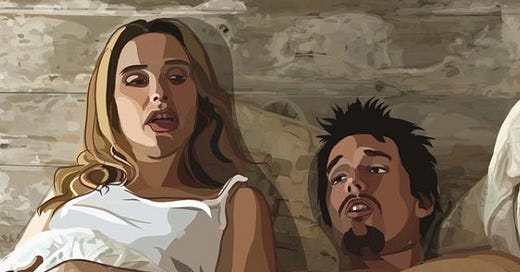Heroes of the Zeroes: Waking Life
Heroes of the Zeroes is a daily, alphabetical look back at the 365 best films of 2000-2009.
"Waking Life" Rated R 2001
Few filmmakers ramble on with Richard Linklater’s proficiency or persuasiveness — easily distracted, endlessly fascinating conversations born of spontaneous improvisation, not rigid scripting.
And 2001’s “Waking Life” — a far-out-man poetry slam, art exhibit and imaginative philosophical discourse all at once — drifts gently down a stream of consciousness until merrily, merrily, merrily, merrily, “Life” is but a dream. Who says existential fiction must concern only life’s burdens, not also its exuberant possibilities?
Layering undulating animation over live-action as he did in “A Scanner Darkly,” Linklater thrillingly journeys to the film medium’s tipping point: “Life” seems to exhale its stoner reveries and sober truths right in front of you.
As was “The Girlfriend Experience” from Steven Soderbergh (turning up to decry “Life’s” lack of commercial viability), “Life” is, partially, Linklater’s exposition on how audiences cognitively interpret movies — namely how they make life’s “holy” moments secular.
Mostly though, “Life” is interconnected interludes of waking, or slumbering, consciousness in the head of Wiley Wiggins — playing himself and soliciting advice on, well, the meaning of meaning. Some discourse clearly takes place in Wiley’s mind, but life and dreams start bleeding together with mysterious slipperiness.
Linklater’s rotoscoped animation is more fancifully untethered than in “Scanner” — fixed objects and orbits no matter, as free-floating watercolor backgrounds hitch as if on a gimbal.
Other than unquenchable curiosity to constantly challenge, rattle, rebel, innovate and churn, Linklater endorses no specific philosophy.
Like photos on a light table, “Waking Life” is meant for reorganization and reconstitution into new interpretations each time.



